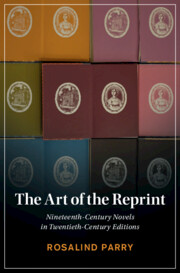Book contents
- The Art of the Reprint
- Cambridge Studies in Nineteenth-Century Literature and Culture
- The Art of the Reprint
- Copyright page
- Dedication
- Contents
- Figures
- Acknowledgments
- Introduction
- Chapter 1 Clare Leighton & Thomas Hardy’s The Return of the Native
- Chapter 2 Rockwell Kent & Herman Melville’s Moby Dick
- Chapter 3 Fritz Eichenberg & Charlotte Brontë’s Jane Eyre
- Chapter 4 Joan Hassall & The Complete Novels of Jane Austen
- Coda
- Notes
- Bibliography
- Index
- Cambridge Studies in Nineteenth-Century Literature and Culture
Chapter 3 - Fritz Eichenberg & Charlotte Brontë’s Jane Eyre
Published online by Cambridge University Press: 23 March 2023
- The Art of the Reprint
- Cambridge Studies in Nineteenth-Century Literature and Culture
- The Art of the Reprint
- Copyright page
- Dedication
- Contents
- Figures
- Acknowledgments
- Introduction
- Chapter 1 Clare Leighton & Thomas Hardy’s The Return of the Native
- Chapter 2 Rockwell Kent & Herman Melville’s Moby Dick
- Chapter 3 Fritz Eichenberg & Charlotte Brontë’s Jane Eyre
- Chapter 4 Joan Hassall & The Complete Novels of Jane Austen
- Coda
- Notes
- Bibliography
- Index
- Cambridge Studies in Nineteenth-Century Literature and Culture
Summary
Before his commission to illustrate Charlotte Brontë’s Jane Eyre, Fritz Eichenberg (1901–90) had neither read the novel nor been to Britain. To illustrate it from New York and in the middle of World War II, he imaginatively occupied Jane’s lucid gaze. Brontë’s first-person account seems so profoundly personal that many Victorian readers thought that, as its subtitle “An Autobiography” suggested, it must be a memoir. Woolf said that to write down one’s impressions of the novel year after year would be tantamount to recording the story of one’s life. The same could be said of illustrating it. Eichenberg had fled Berlin for New York with his Jewish family in 1933, motivated by fear of retribution for his anti-Hitler cartoons. As he immersed himself in visualizing Jane’s voice, and shaping his figures, background, and compositions around her perspective, he overlaid his experience of flight, emigration, and movement onto Jane’s. His gouging, roughly hewn engravings are a self-portrait, narrativized not by his life events but by Jane’s. His Jane Eyre is also telling of a culture of collection and ownership; the Book-of-the-Month Club distributed his edition to subscribers.
Keywords
- Type
- Chapter
- Information
- The Art of the ReprintNineteenth-Century Novels in Twentieth-Century Editions, pp. 94 - 123Publisher: Cambridge University PressPrint publication year: 2023

